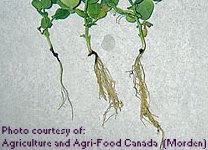Foot Rot and Mycosphaerella Blight
These diseases are closely related and can cause serious losses in peas particularly in the higher moisture regions of the Prairies.


Host Crops
Field peas
Biology
Both fungi are stubble, seed, and soil borne and can survive for several years in the soil as resting spores. Initial infection occurs as the plant shoots come in contact with resting spores or by the fungus growing from seed across the point of attachment to the seedling. Infection from the seed develops as a foot lesion. Spores are produced from reproductive bodies of the fungus and released during wet weather to initiate leaf infection. During the growing season, new reproductive bodies are produced and release spores during wet periods to establish new infections.
Symptoms Of Damage
Symptoms of foot rot usually begin at the point of seed attachment and extend as a bluish-black lesion to above the soil line.
Blight symptoms occur on leaves as small, purple lesions with indefinite margins that turn brownish-black and develop a target-like appearance. Lesions coalesce and leaves may dry up but remain attached to the stem. The lesions on the stem are purple and may extend 10 mm (3/8 in.) above and below the point of leaf attachment. Infection of the flowers cause the blossoms to drop. Small, purple lesions develop on infected pods. The pods may shrink if the infection is severe. Infected seeds may show various degrees of shrinkage and discolouration or they may show no signs of infection.
Scouting Techniques
Look for bluish-black lesions on the stem. Note that stem lesions may merge and give the entire lower stem a bluish-black appearance. Infected pods are covered with small, purple lesions. The pods may appear shrunken if the infection is severe.
Control Tips
- Use disease-free seed and follow a 5-year crop rotation. Plant peas as far away as possible from previously infected fields.
- Cultivate crop residue under immediately after harvest. Treat seed with a recommended fungicide.

